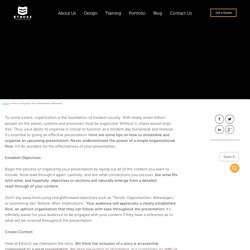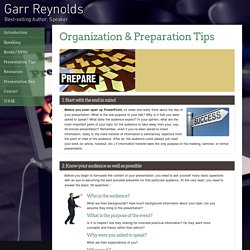

Welcome to mindmapping.com. Log In to Mind Tools. Log In to Mind Tools. 10 Ways To Organize Instructional Content. People who create online learning get involved in many types of content development tasks.

In addition to researching and developing content for courses, you may find yourself creating training manuals for webinars or the classroom, writing web copy, making reference materials, and developing Electronic Performance Support Systems, Help documentation, presentations and so on. During all of these tasks, you will be organizing content at a high level to give it a meaningful structure. A meaningful structure is logical, helping people to comprehend and retain the content as well as helping them quickly find the content they need. Assuming that you’ve sufficiently wrapped your mind around the content, use the list below to find the most effective strategy for organizing it.
Sticking to one high-level strategy will help streamline the design process and it helps learners and users understand the larger framework of a course, website or document. 1. 2. Some content has a flat structure. 3. 4. Presentation Organization: Different Structures. These four structures have contrast inherently built into them and work for persuasive presentations: /1 Problem-solution: Arrange information by stating the problem and then the solution.

Establishing that there’s a problem helps convince people of the need for change. /2 Compare-contrast: Arrange information according to how two or more things are different from or similar to one another. . /3 Cause-effect: Arrange information to show the different causes and effects of various situations. . /4 Advantage-disadvantage: Arrange information into “good” or “bad” categories. Select your organizational structure based on which one makes the most sense to support your big idea. How to Organize Your Presentation Effectively. To some extent, organization is the foundation of modern society.

With nearly seven billion people on the planet, systems and processes must be organized. Without it, chaos would reign free. Thus, your ability to organize is critical to function as a modern day humanoid, and likewise it’s essential to giving an effective presentation. Here are some tips on how to streamline and organize an upcoming presentation.
Never underestimate the power of a simple organizational flow. Establish Objectives Begin the process of organizing your presentation by laying out all of the content you want to include. Don’t shy away from using straightforward objectives such as “Trends. Create Context Here at Ethos3, we champion the story. So if your content revolves around the financial crisis, for example, it’s important to include a backstory, perhaps, of before and after the crisis, how things are different, how the business has changed, etc. Full Circle. Organising Your Material - Presentation Skills. Regardless of whether your presentation is going to be delivered formally, such as at work or informally, for a club or perhaps a Best Man's speech.

You should always aim to give a clear, well-structured delivery. That is, you should know exactly what you want to say and the order in which you want to say it. Having thought about and planned a good structure will also help to alleviate any nervousness you may be feeling in the build up to your talk. Clarity of ideas and good organisation should help result in a lively, logical and compelling message, delivered in a confident and professional way Organising the presentation material may include: Blue Sky Thinking (the ideas). Blue Sky Thinking (The Ideas) Keeping your objectives in mind (see our page: Preparing Your Presentation), write down all the points you wish to make, irrespective of order.
For an introduction to Blue Sky Thinking, see our section on Brainstorming - part of our guide to problem solving. Select Your Main Points As a guide: Organization & Preparation Tips. Before you even open up PowerPoint, sit down and really think about the day of your presentation.

What is the real purpose of your talk? Why is it that you were asked to speak? What does the audience expect? In your opinion, what are the most important parts of your topic for the audience to take away from your, say, 50-minute presentation? Remember, even if you’ve been asked to share information, rarely is the mere transfer of information a satisfactory objective from the point of view of the audience. Before you begin to formulate the content of your presentation, you need to ask yourself many basic questions with an eye to becoming the best possible presenter for that particular audience.
Who is the audience? What are their backgrounds?